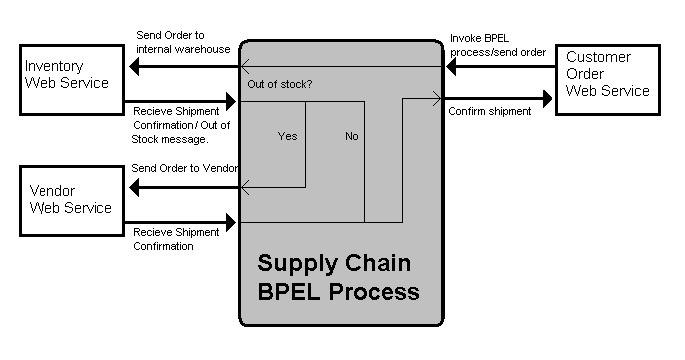Business Process Execution Language (BPEL) was developed as part of a cooperative initiative by IBM, BEA, and Microsoft. This XML-based language is basically a combination of IBM's Web Services Flow Language (WSFL) and Microsoft's XLang. The resulting language is also known as BPEL for Web Services, or BPEL4WS.
BPEL4WS is a means by which to link Web services together into a single business process. The BPEL process contains a series of steps called "activities." The table below contains a list of primitive activities supported by BPEL4WS. These primitive activities allow the BPEL process to communicate with other partner services.
| Primitive Activities | |
| Activity | Description |
| | Invokes an operation on a Web service |
| | Waits to receive a request for an operation to be invoked by an external requester |
| | Replies to an I/O operation |
| | Copies data |
| | No operation performed |
| | Terminates the service instance |
| | Throws an error condition |
| | Waits for a specified amount of time |
The basic roles of the BPEL process are to invoke services using the
In addition to these primitive activities, BPEL4WS also supports a set of structure activities that, when combined with the primitive activities, allow for the creation of more complex processes. A list of the structure activities is shown in the table below.
| Structure Activities | |
| Activity | Description |
| | Defines activities to be performed concurrently |
| | Executes an alternate path |
| | Defines a sequence of steps |
| | Allows for branching control |
| | Defines a loop |
These activities give more detailed control over the BPEL process flow as an IF or CASE statement might in traditional programming languages. The
Swing Your Partner
Services and clients that interact with BPEL processes are referred to as "partners." Partners can include services that are invoked by the process, services that invoke the process, and services that invoke the process and are invoked by the process. This means that a client service may invoke a BPEL process and, as a result, may be invoked itself by that process. By the same token, a BPEL process may invoke a service that in turn invokes the BPEL process. For example, a given BPEL process may invoke a service that at some later point will invoke the BPEL process to return the required data. It's important to note that the service invoked may be a Web service internal to your organization or a service hosted by an external partner (a vendor or customer, for example). Figure 1 shows an example of a simple supply chain-based BPEL process.

Figure 1: Here's an example of a simple supply chain BPEL process. (Click image to enlarge.)
In this example, a customer order Web service initiates the BPEL supply chain process. This process forwards the order information to the company's internal inventory/warehouse service. This service determines stock availability and sends back either a shipment confirmation message or an out-of-stock message. If the item ordered is out of stock, the BPEL process forwards the order to an external vendor's Web service. When the vendor ships the order to the customer, the vendor's Web service in turn sends a shipment confirmation back to the BPEL process. Once the order has been shipped, the BPEL process forwards the confirmation message back to the customer order system's Web service. This simple example helps to illustrate the interaction of multiple Web services into a single business process.
Software Resources
Many tools are available to help you to build BPEL processes. IBM's BPEL tool offering is Business Process Execution Language for Web Services Java Run Time (BPWS4J). BPWS4J uses a SOAP interface to make the BPEL4WS document available as a Web service. In addition, BPWS4J includes a plug-in to give you the ability to edit BPEL4WS files inside of Eclipse. BPWS4J is compatible with the Apache and Tomcat Web servers. Microsoft includes support for BPEL processes within its BizTalk Server product. Microsoft also has support for designing and implementing BPEL documents within its Visio tool and Visual Studio.Net, both of which can be used to design a business process and output a BPEL document. The resulting BPEL document is then executed within the BizTalk Server. Active Endpoints, Inc. (AEI) offers an open-source BPEL solution called ActiveBPEL engine. ActiveBPEL engine offers full support for BPEL4WS 1.1 specifications. This open-source product is incorporated in several other commercial products offered by AEI. This helps ensure commitment to the development of the open-source product. Oracle has a BPEL solution called Oracle BPEL Process Manager. Like the others, this product offers full support for BPEL 1.1, as well as an easy-to-use visual designer.
Improving Supply Chain Management with BPEL
By extending XML Web services in this manor, supply chain management is greatly improved by the ability to automate the physical business processes that are already occurring. The standards-based approach of BPEL eliminates the use of proprietary languages to build your business process, and the number of heavy hitters in the software industry offering BPEL solutions only helps to emphasize the role that this technology is poised to take.
Mike Faust is a Business Analyst for Invivo Corporation in Orlando, Florida. Mike is also the author of the books The iSeries and AS/400 Programmer's Guide to Cool Things and Active Server Pages Primer and SQL Built-in Functions and Stored Procedures. You can contact Mike at
















 Business users want new applications now. Market and regulatory pressures require faster application updates and delivery into production. Your IBM i developers may be approaching retirement, and you see no sure way to fill their positions with experienced developers. In addition, you may be caught between maintaining your existing applications and the uncertainty of moving to something new.
Business users want new applications now. Market and regulatory pressures require faster application updates and delivery into production. Your IBM i developers may be approaching retirement, and you see no sure way to fill their positions with experienced developers. In addition, you may be caught between maintaining your existing applications and the uncertainty of moving to something new. IT managers hoping to find new IBM i talent are discovering that the pool of experienced RPG programmers and operators or administrators with intimate knowledge of the operating system and the applications that run on it is small. This begs the question: How will you manage the platform that supports such a big part of your business? This guide offers strategies and software suggestions to help you plan IT staffing and resources and smooth the transition after your AS/400 talent retires. Read on to learn:
IT managers hoping to find new IBM i talent are discovering that the pool of experienced RPG programmers and operators or administrators with intimate knowledge of the operating system and the applications that run on it is small. This begs the question: How will you manage the platform that supports such a big part of your business? This guide offers strategies and software suggestions to help you plan IT staffing and resources and smooth the transition after your AS/400 talent retires. Read on to learn:
LATEST COMMENTS
MC Press Online